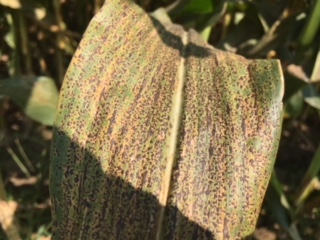If you do not think tar spot is an issue for corn production in Illinois and the region, please view this video from our colleague in Northern Illinois. This is why I have been receiving several calls and emails daily on this disease, and many people are wondering what we know and what they can do to manage it. The bottom line is that we do not really know and we are working on it.
The literature on this disease from it’s native range in Latin America is sparse and incomplete, and little is known about pathogen biology or epidemiology (how the disease develops and spreads). Furthermore, it is possible that the disease acts differently in the United States due to environment, production practices, etc. We are working with the Smith lab at UW Madison and others in the region to acquire as much information on disease impact, management, pathogen biology, and epidemiology as possible this season, and hopefully we will have more information for everyone in our Winter meetings. In the meantime, here are a few points to keep in mind:
1) What is up with fisheye lesions? In Latin America, primarily Mexico, fisheye lesions in the Tar Spot Complex are associated with the presence of the fungus Monographella maydis. It has never been proven that this organism actually causes these lesions. It is possible that it is simply a secondary invader, common to that area, that colonizes dead tissues. It is also possible that another organism could have a similar role in our region as Monographella has in Mexico. A third possibility is that it could be simply a response of Phyllachora with the corn hybrid. We have observed fields with plants containing fisheyes and some without, but the end result, rapid drying and dieback, seems to be the same regardless of the presence of fisheye lesions. Currently we have not identified a second organism consistently associated with these lesions, but we are working on this and will inform you of the results as soon as they are in.

2) Hybrids may differ in susceptibility to Tar spot. In Latin America, this is the most important and effective means to manage this disease. We are collecting hybrid response data, and hopefully industry is doing this as as well, so you can avoid planting the more susceptible varieties in subsequent years. This will be the key for the upcoming season.
3) We do not understand the biology of the disease or it’s epidemiology. Therefore the feasibility, profitability, and reliability of fungicide treatments for in season management are unknown. If you do not know when the fungus arrives, how can you ensure that your fungicide is applied at the correct time? This season we have seen as many fields with a fungicide applied with no effect as fields where a fungicide was applied and there was an effect. In Latin America they do use fungicides to assist in disease management, albeit different ones from ours in the United States. I would be skeptical about fungicide utility until we have more information to demonstrate their utility and optimal products, timings, etc.
4) Yes, we have seen this every year. Why more this year? Perhaps it was the frequent and heavy rains we had in the July and August? When we first detected the pathogen in 2015 it was following particularly wet conditions. Perhaps the pathogen needed to build up to greater levels? Is is going to be a consistent threat? Only time will tell.
5) It likely overwinters here. How? It could be residue. It could be on weeds or other plants in the environment. This is another question we hope to start tackling in the future.
In the meantime, we are still interested in collecting samples affected by tar spot. Samples can be sent to Diane Plewa at the University of Illinois Plant Diagnostic Clinic. Hopefully we can acquire funds in the future so we can continue to address this issue for Illinois and Midwestern corn producers.

